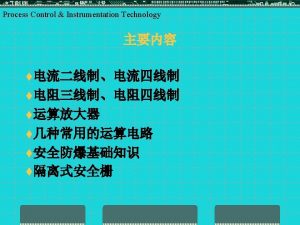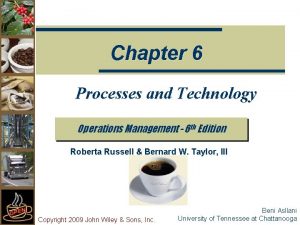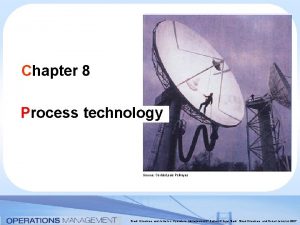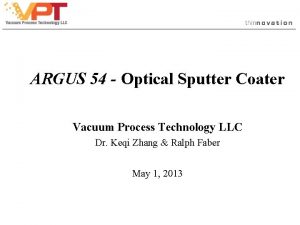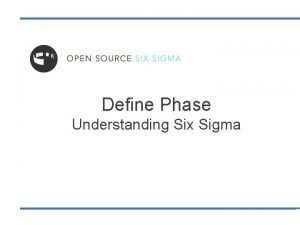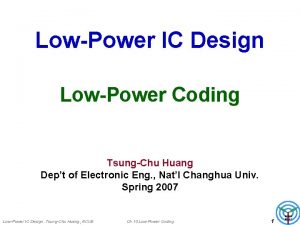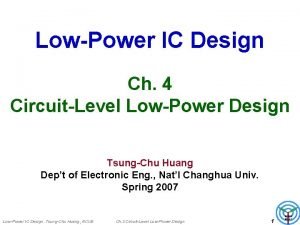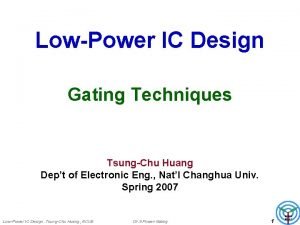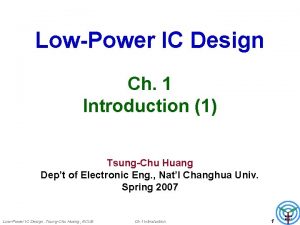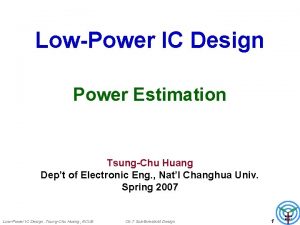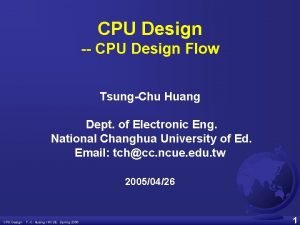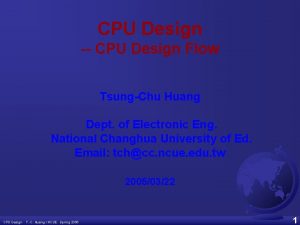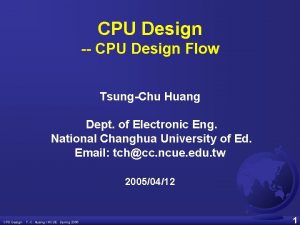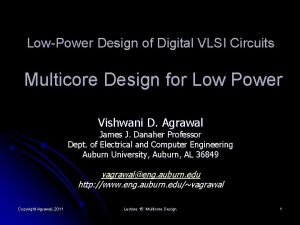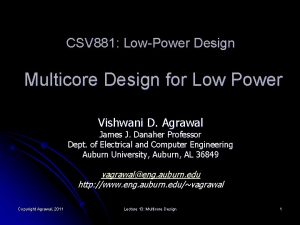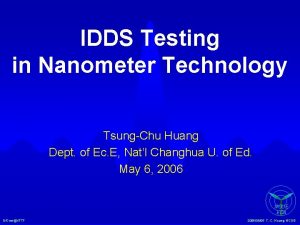LowPower IC Design Ch 3 Process Technology TsungChu
















- Slides: 16

Low-Power IC Design Ch. 3 Process Technology Tsung-Chu Huang Dep’t of Electronic Eng. , Nat’l Changhua Univ. Spring 2007 Low-Power IC Design. Tsung-Chu Huang, NCUE Ch. 3 Process Technology 1 NCUE EDAT

Progress (Sub-)Systems Low-Power Testing (Combinatory) Algorithms Coding (Micro-)Architecture Power-Gating Logics Sub-threshold Design Circuits Low-Voltage Design Process Technology Modeling and Definitions Levels Parametric Modules Low-Power IC Design. Tsung-Chu Huang, NCUE Ch. 3 Process Technology 2 NCUE EDAT

Rethink from Process to the Equations • Low-Power Processes: – Low-Leakage Processes: • SOI (Semiconductor on Insulator) Process – Low-Voltage Processes: • Low-Cj (Junction capacitance), Low-Cp (parasitic) • Low-Isub (subthreshold current) for MTCMOS – Bi. CMOS Processes: • Bi. Polar + CMOS Low-Power IC Design. Tsung-Chu Huang, NCUE Ch. 3 Process Technology 3 NCUE EDAT

Why CMOS Process • Complementary Metal-Oxide-Semiconductor – Consumption • IDDQ=0 when static power dissipation = 0. – Margin • Noise margin ~ (Vdd/2 -Vth) – Operation range • Large range for Vdd/Vth • Working temperature – Simplicity • Layout • Regularity Low-Power IC Design. Tsung-Chu Huang, NCUE Ch. 3 Process Technology 4 NCUE EDAT

Reviews on Typical CMOS Process • Chapter 2 in “Introduction to VLSI Design” – Click here from website http: //163. 223. 30/tch/lecture/VLSIDesign 2006/VLSI 02. ppt – Click here from the file in the current directory. Low-Power IC Design. Tsung-Chu Huang, NCUE Ch. 3 Process Technology 5 NCUE EDAT

Voltage Scaling PDP Power Delay 1 5 9 VDD/Vth • Constant-Variable Scaling for Simplification – Constant Voltage (VDD/Vth Ratio) (CV) Scaling • VDD/Vth~5 – Constant Electric Field (CE) Scaling • Eox=VDD/tox, Efox=VDD/tfox – Quasi-Constant Voltage Scaling • More aggressive. Low-Power IC Design. Tsung-Chu Huang, NCUE Ch. 3 Process Technology 6 NCUE EDAT

Leakage Current Mechanisms I 7 I 8 Polysilicon Gate oxide Source Drain n+ n+ I I I 2 3 6 I 5 I 1 I 4 p substrate I 4 GIDL I 5 punchthrough I 6 narrow width effect Bulk (Body) Low-Power IC Design. Tsung-Chu Huang, NCUE I 1 p-n junction reverse bias current (drain junction) I 2 weak inversion (subthreshold current) I 3 DIBL Ch. 3 Process Technology I 7 gate oxide tunneling (gate leakage) I 8 hot carrier injection 7 NCUE EDAT

Leakage as a Function of Design Time VT • Reducing the VT increases the subthreshold leakage current (exponentially) – 90 m. V reduction in VT increases leakage by an order of magnitude • But, reducing VT decreases gate delay (increases performance) • Determine the critical path(s) at design time and use low VT devices on the transistors on those paths for speed. Use a high VT on the other logic for leakage control. – A careful assignment of VT’s can reduce the leakage by as much as 80% Low-Power IC Design. Tsung-Chu Huang, NCUE Ch. 3 Process Technology 8 NCUE EDAT

Low-Voltage CMOS Process • Low-Voltage Process – Thicker Thinox Area • 10 nm → 40 nm – LOCOS (Local Oxidation of Silicon) • Vdd < FOX (Field) Threshold Voltage 1 5 • Raise doping level of Channel Stopper (under FOX) Leakage t. Fox 9 – Low-Cj (Junction capacitance), Low-Cp (parasitic) • Distance of the depletion region → d/A↑ • Shallow junction well (SFET) – Low-Isub (subthreshold current) for MTCMOS • Low doping level (concentration n) of the active region Low-Power IC Design. Tsung-Chu Huang, NCUE Ch. 3 Process Technology 9 NCUE EDAT

TSMC Processes Leakage and VT CL 018 G CL 018 LP CL 018 ULP CL 018 HS CL 015 HS CL 013 HS Vdd 1. 8 V 2 V 1. 5 V 1. 2 V Tox (effective) 42 Å 29 Å 24 Å Lgate 0. 16 m 0. 18 m 0. 13 m 0. 11 m 0. 08 m IDSat (n/p) ( A/ m) 600/260 500/180 320/130 780/360 860/370 920/400 20 1. 60 0. 15 300 1, 800 13, 000 0. 42 V 0. 63 V 0. 73 V 0. 40 V 0. 29 V 0. 25 V 30 22 14 43 52 80 Ioff (leakage) ( A/ m) VTn FET Perf. (GHz) From MPR, 2000 Low-Power IC Design. Tsung-Chu Huang, NCUE Ch. 3 Process Technology 10 NCUE EDAT

Ileakage(n. A/ m) Exponential Increase in Leakage Currents Temp(C) From De, 1999 Low-Power IC Design. Tsung-Chu Huang, NCUE Ch. 3 Process Technology 11 NCUE EDAT

Multiple VDD Considerations • How many VDD? – Two is becoming common – Many chips already have two supplies (one for core and one for I/O) • When combining multiple supplies, level converters are required whenever a module at the lower supply drives a gate at the higher supply (step-up) – If a gate supplied with VDDL drives a gate at VDDH, the PMOS never turns off VDDH • The cross-coupled PMOS transistors do the level conversion Vout • The NMOS transistor operate on a VDDL Vin reduced supply – Level converters are not needed for a step-down change in voltage – Overhead of level converters can be mitigated by doing conversions at register boundaries and embedding the level conversion inside the flipflop (see Figure 11. 47) Low-Power IC Design. Tsung-Chu Huang, NCUE Ch. 3 Process Technology 12 NCUE EDAT

Dual-Supply Inside a Logic Block • Minimum energy consumption is achieved if all logic paths are critical (have the same delay) • Clustered voltage-scaling – Each path starts with VDDH and switches to VDDL (gray logic gates) when delay slack is available – Level conversion is done in the flipflops at the end of the paths Low-Power IC Design. Tsung-Chu Huang, NCUE Ch. 3 Process Technology 14 NCUE EDAT

Short Channel Factors and Stack Effect • In short-channel devices, the subthreshold leakage current depends on VGS, VBS and VDS. The VT of a short-channel device decreases with increasing VDS due to DIBL (drain-induced barrier loading). – Typical values for DIBL are 20 to 150 m. V change in VT per voltage change in VDS so the stack effect is even more significant for short-channel devices. – VX reduces the drain-source voltage of the top nfet, increasing its VT and lowering its leakage even more • For our 0. 25 micron technology, VX settles to ~100 m. V in steady state so VBS = -100 m. V and VDS = VDD -100 m. V which is 20 times smaller than the leakage of a device with VBS = 0 m. V and VDS = VDD Low-Power IC Design. Tsung-Chu Huang, NCUE Ch. 3 Process Technology 15 NCUE EDAT

Simplified Typical Bipolar Process • BJT (Bipolar-Junction Transistor) – Q 1 C B E A=area of Collector – Click Here for Addendum File, Process 1 – Click Here for Addendum File, Process 2 Low-Power IC Design. Tsung-Chu Huang, NCUE Ch. 3 Process Technology 16 NCUE EDAT

Isolation btw CMOS/BJT FOX CMOS • LOCOS – tfox~0. 5 um, Local Oxidation of Semiconductor; doping under FOX • Trench Isolution – Trenched before thinox • Dummy Device – Welled turned off MOS transistor Low-Power IC Design. Tsung-Chu Huang, NCUE Ch. 3 Process Technology 17 NCUE EDAT
 The technology design process
The technology design process Split range
Split range Mj gregorys technology management model
Mj gregorys technology management model Test permis hauturier
Test permis hauturier Process control instrumentation technology
Process control instrumentation technology Technological forecasting
Technological forecasting What is process technology in operations management
What is process technology in operations management Techjm.xyz free
Techjm.xyz free Process technology examples
Process technology examples Project management process technology and practice
Project management process technology and practice Technology commercialization process model
Technology commercialization process model Vacuum process technology
Vacuum process technology Technology process definition
Technology process definition Lee college process technology
Lee college process technology Final quality
Final quality Sample design and technology gcse examination paper answers
Sample design and technology gcse examination paper answers Sample design and technology gcse examination paper answers
Sample design and technology gcse examination paper answers




